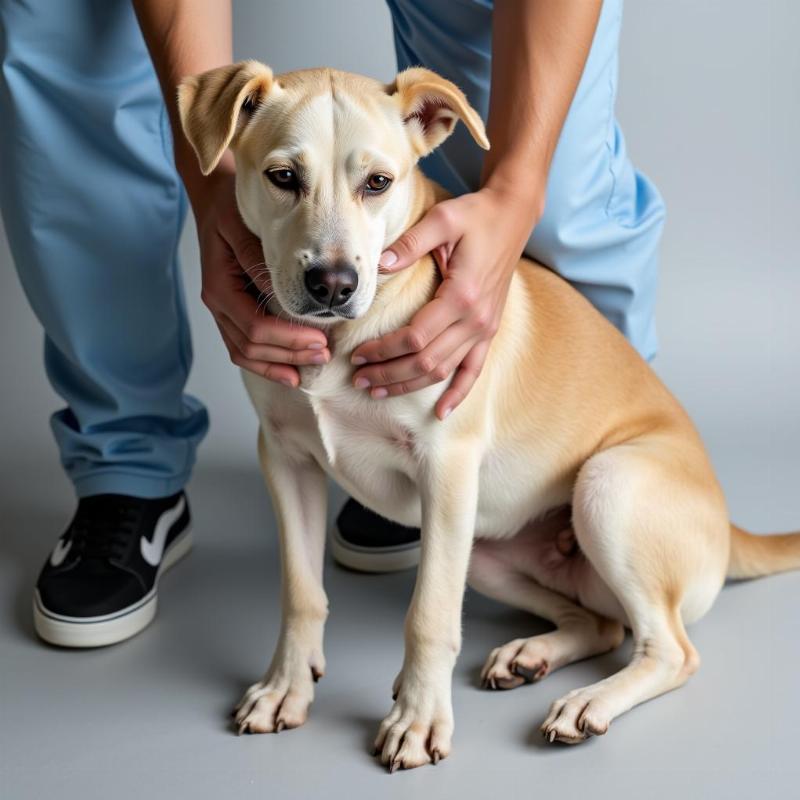Pee pads can be a helpful tool for older dogs experiencing incontinence or mobility issues. As our furry friends age, they may face challenges controlling their bladder or have difficulty getting outside in time. This is where pee pads can offer a convenient solution, providing a designated indoor spot for relief. However, using pee pads with older dogs isn’t always a simple fix and requires a thoughtful approach. Let’s explore the effectiveness of pee pads for senior dogs, considering both the benefits and potential drawbacks.
Understanding the Challenges of Senior Dog Incontinence
Senior dog incontinence can stem from various factors, including weakened bladder muscles, cognitive decline, arthritis, or certain medical conditions. Recognizing the underlying cause is crucial for effective management. For instance, a dog with arthritis might struggle to get up and move quickly to go outside, while a dog with cognitive decline might simply forget house-training. A visit to your veterinarian is the first step in addressing incontinence, as they can diagnose the cause and recommend appropriate treatment options.
 Nguyên nhân gây tiểu không tự chủ ở chó già
Nguyên nhân gây tiểu không tự chủ ở chó già
Pros and Cons of Pee Pads for Older Dogs
Pee pads offer several advantages for senior dogs:
- Convenience: They provide an easily accessible indoor potty spot, especially helpful for dogs with mobility issues or those living in apartments.
- Reduced Accidents: Pee pads can minimize accidents on carpets and furniture, making cleanup easier for owners.
- Maintaining Dignity: They can help older dogs maintain a sense of dignity by providing a designated spot for relief when they can’t make it outside.
However, there are also potential downsides:
- House-Training Confusion: Some older dogs might struggle to differentiate between the pee pad and other indoor surfaces, leading to continued accidents.
- Hygiene Concerns: Regularly changing pee pads is essential to prevent odor and maintain a sanitary environment.
- Not a Long-Term Solution: While pee pads offer a practical solution in certain situations, they shouldn’t replace addressing the underlying cause of incontinence.
Tips for Successfully Using Pee Pads with Older Dogs
- Choose the Right Pad: Opt for absorbent, leak-proof pee pads with attractant scents to encourage use.
- Introduce Gradually: Start by placing the pee pad in a convenient and easily accessible location.
- Positive Reinforcement: Reward your dog with praise and treats when they successfully use the pad.
- Consistency is Key: Maintain a regular potty break schedule and take your dog outside frequently, even if they primarily use pee pads.
- Consult Your Veterinarian: Discuss your dog’s incontinence with your veterinarian to rule out underlying medical conditions and explore potential treatments.
When Pee Pads Aren’t Enough
Sometimes, pee pads alone aren’t sufficient to manage senior dog incontinence. If your dog continues to have frequent accidents despite using pee pads, consider consulting a veterinary behaviorist. They can help identify any behavioral or cognitive factors contributing to the problem and develop a tailored training plan. Additionally, your veterinarian might recommend medications or other interventions to manage the underlying medical condition causing incontinence.
Conclusion
Pee pads can be a valuable tool for managing incontinence in older dogs, offering convenience and reducing accidents. However, they’re most effective when used in conjunction with veterinary guidance and a consistent training approach. Remember, addressing the root cause of incontinence is crucial for ensuring your senior dog’s long-term health and well-being. Don’t hesitate to reach out to your veterinarian or a veterinary behaviorist for support. They can provide personalized recommendations to help you navigate this challenging aspect of senior dog care.
FAQ
- Do all older dogs need pee pads? No, not all older dogs require pee pads. Their use depends on the individual dog’s health and specific needs.
- Can pee pads be used for dogs of all ages? Yes, while often associated with puppies and seniors, pee pads can be useful for dogs of any age with incontinence or mobility issues.
- Are there alternatives to pee pads? Yes, alternatives include dog diapers, belly bands, and frequent outdoor potty breaks.
- How often should I change pee pads? Pee pads should be changed immediately after each use to maintain hygiene and prevent odor.
- What if my dog refuses to use the pee pad? Try different brands with attractant scents, relocate the pad to a more accessible area, or consult a trainer for assistance.
- Can I train an older dog to use a pee pad? Yes, older dogs can be trained to use pee pads with patience, consistency, and positive reinforcement.
- Are there any health risks associated with using pee pads? If not changed regularly, pee pads can create unsanitary conditions. Some dogs might also try to ingest the pad material, posing a choking hazard.
Related Articles on Beautdogs.us
- boarding my dog for the first time
- st simons island dog boarding
- how to get a service dog in tennessee
- vetri mega probiotic for dogs
Beautdogs.us is your premier online resource for comprehensive dog care information, breed-specific insights, and access to the latest products and services for your canine companion. Whether you’re a new dog owner or a seasoned expert, Beautdogs.us empowers you with the knowledge and tools to provide exceptional care for your furry friend. Connect with us today to learn more! Email: [email protected], Phone: +1 501-555-7529. Visit Beautdogs.us for a wealth of valuable resources dedicated to enhancing the well-being of your beloved dog.